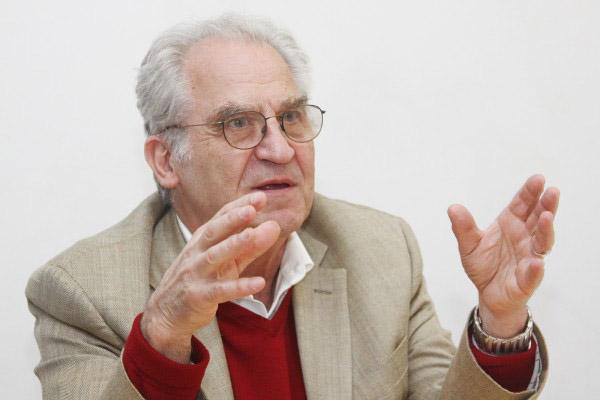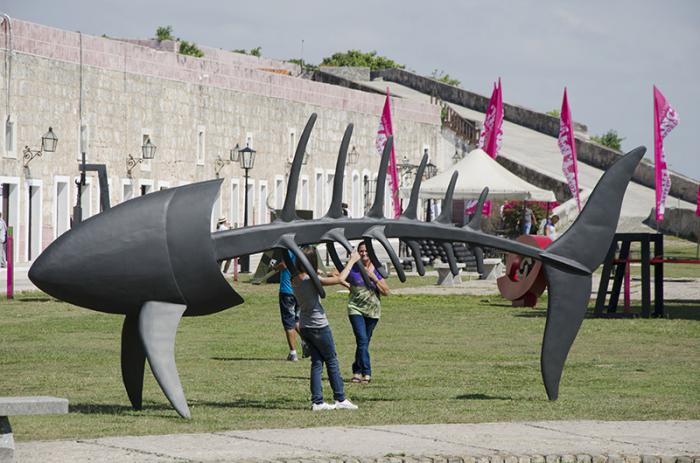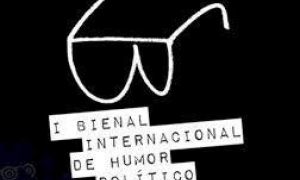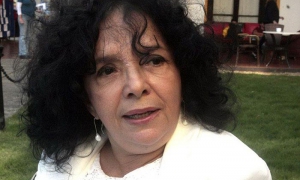
Artists from 42 countries, invited to the 12th Havana Biennial, on May 22 began a direct dialogue with the Cuban public, inserting their work into the urban environment.
The curators’ proposal focused on city spaces has as its title Entre la idea y la experiencia. (Between the idea and the experience) “It is absolutely revolutionary, directed toward a dynamic, horizontal dialogue, with the most diverse publics,” said Biennial President Rubén del Valle, also head of the Visual Arts Council, during a press conference at the Bertolt Brecht Café-Theater in Havana.
He cited an essential element, “Despite all of the difficulties, including the economic ones, Cuba has decided to preserve one of the most important events on the Cuban cultural scene, and changed what was understood as contemporary art on a global level.”
It must be recalled that the first Biennial in 1984, reflected the focus on art from the Third World, first with a Latin American perspective and later including other regions. As Del Valle said, “It was about attempting to give the excluded a voice.”
Del Valle went on the point out that the Biennial is the great platform from which Cuban art is projected internationally, emphasizing the importance of the broad range of parallel activities underway around the city.
The exhibition reflects the richness of contemporary Cuban art and the dialogue underway between generations.
For example, under the title of Zona Franca, more than 190 projects are being presented at the Morro-Cabaña historical complex, a veritable mega-exposition.
Additionally during the Biennial’s entire month, May 22 – June 22, the project Open studio will provide an opportunity to visit artists’ studios, to see first hand how their creative work is done.

Other details of the Biennial were presented at the press conference by Jorge Fernández, director of the Wifredo Lam Center, who noted that close to 1,000 artists, both Cuban and from abroad – including those participating in collateral events – are showing their works.
“Artists, from different countries, philosophies, and ways of working traveled to the island to do their work here, and thus had a real insertion into the Cuban context.”
The artists have worked with professional and scientific communities and in different neighborhoods, Fernández reported, “We are talking about art that opts for the social, for changing the community’s life.” Thus works are to be found in the city’s central public plazas, in outlying neighborhoods, and along Havana’s famous Malecón.
Precisely among the parallel expositions is the second edition of Detrás del Muro, erected on the renowned seawall, this year with more than 51 projects by 61 artists.
Announced at the press conference was the participation of celebrated Cuban artists Manuel Mendive and Roberto Fabelo, and expectations are high for the piece by Duke Riley from the United States, an “ice” skating rink, created with a material which has similar characteristics, but, fortunately, doesn’t melt.
The 1,000 plus participating artists have converted Havana into a giant open air exhibition, to present their work, principally in public performances, itinerant projects and expositions throughout the city, as well as in a dozen collective projects.
Some shows: the Afghan-American Aman Mojadidi is presentig his work on migration and especially the U.S. prison on the illegally occupied Guantánamo naval base. His proposal takes place on the roof of the commuter ferry to Casablanca, which connects this community to the city, while Brazilian Regina called her project Phantasmata, and presented it in parking lots near Havana Vieja’s La Maestranza Park and Artisans’ Center, on Avenida del Puerto.
Noteworthy among the collective projects is Montañas con una esquina rota, which is enlivening the old bicycle factory on Línea and 18th with a show put on by 15 artists from 12 countries (Abraham Cruzvillegas. Mexico / Michel Francois. Belgium / Ryan Gander. UK / Hans Haacke. Germany / Pierre Huyghe. France / Gabriel Kuri. Mexico / Tatiana Mesa. Cuba / Helen Mirra. USA / Navid Nuur. Iran / Roman Ondak. Slovakia / Eduardo Ponjuan. Cuba / Ariel Schlesinger. Israel / Shimabuku. Japan / Roman Signer. Switzerland / Richard Wentworth. UK).
According to one of its curators, Gretel Medina, “It is a project conceived on the basis of site specific interventions which generate a dialogue with history, the physical remains, the intangible memory of the place… A group of works has emerged which transcend the factory’s physical space to become part of the urban fabric and interact with neighboring sites and with the people who live in the vicinity.”
Joining this focus on industrial facilities is Cuban artist Esterio Segura who has entitled his work Habana [re] generación located around the shuttered Talla Piedra thermoelectric generating station.
Another show which coincides with, and enriches, the Biennial is that of Uruguayan artist and theorist Luis Camnitzer, one of the great references of conceptual Latin American art, open at the Casa de Las Americas, where some of his pieces are included in the institution’s Haydee Santamaría Our America Art Collection. The artist will present some of the works which came out of a workshop he offered, as well as the installation and performance innovations developed on site.
Also characterizing the Biennial is its trans-disciplinary nature, highlighted on this occasion by the opera Cubanacán, with music by Roberto Valera, and lyrics by Charles Kopprlman from the U.S. and the staging of Triunfadela,by the theater groupEl Ciervo Encantado, which according to its promotion is “a political, jocular-serious, danceable review… an approach to the rich Cuban tradition of acts, assemblies, marches, demonstrations, tributes, anniversaries, parades, galas…”
Although artists from the U.S. are participating in several projects, their number and role led to a question, to which Jorge Fernández replied, explaining that more than a thousand individuals from that country are accredited to participate in the 11th Havana Biennial, a reflection of the rapprochement underway between the two countries, he said.
For example, an interesting parallel exposition emerged as a result of collaboration between the National Fine Arts Museum and the Bronx Museum in New York, entitled Ruido Salvaje (some 100 works by 54 artists) which includes the emblematic African American flag by David Hammons, hanging on the façade of the Fine Arts Museum’s universal art building.
Already announced, for next year, is a 100-piece exhibition of Cuban art from the 1960s, 70s and 80s at the Bronx museum.
During May and June, Havana is celebrating three uninterrupted decades of the Biennial, an event with many unique features… including the fact that it is held every three years.






